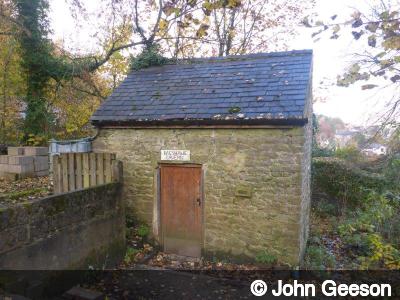You are using an out of date browser. It may not display this or other websites correctly.
You should upgrade or use an alternative browser.
You should upgrade or use an alternative browser.
Cave conservation questions
- Thread starter thehungrytroglobite
- Start date
Stuart France
Active member
English – Coflein
A search for "images Gaewern cars" will deliver to you what Coflein has tactfully omitted.
Obviously the people who put these cars and old tellies down the mine, and most of those visiting there nowadays are not cavers as we know them.
Last edited:
thehungrytroglobite
Well-known member
Please could you provide some examples of this? I haven't yet found an SSSI specification that takes underground features into considerationour cave systems in the National Parks are also Sites of Special Scientific Interest
Have a look at Defra's MAGIC map application for locations of SSSIs. There are many caves and cave systems designated, including Ease Gill:
Here's the entry for Leck Beck Head catchment area SSSI. https://designatedsites.naturalengland.org.uk/SiteDetail.aspx?SiteCode=s1001420
PeteHall
Moderator
Again, a matter up for debate.or sediment to push pins into, then they should be used.
I know (and you know) some people who prefer to stick a rock down and drill the rock, as it's much more stable in the long term than pushing a pin into mud.
I can see both sides of the argument and I guess the best solution may depend on the exact location and the amount of traffic its likely to see.
thehungrytroglobite
Well-known member
Thanks for bringing this to my attention. Great to see that cave management is considered in such detail. It makes me wonder whether similar protection ought to be given to other caves, even those which fall outside of SSSIsHere's the entry for Leck Beck Head catchment area SSSI. https://designatedsites.naturalengland.org.uk/SiteDetail.aspx?SiteCode=s1001420
thehungrytroglobite
Well-known member
I can see there are lots of SSSIs featuring, or even focused on, caves which is great - although of course the fact that something is an SSSI doesn't necessarily give it much protection in practice!
Andy Farrant
Active member
Really?? Many caves are cited as SSSI sites. I suggest you read the relevant GCR volume 'Karst and Caves of Great Britain (Geological Conservation Review Series No. 12)' edited by Tony Waltham (1995) which should be in any good caving club library and online here. That will give you a wealth of information about why many of the caves in our National Parks are SSSI sites.Please could you provide some examples of this? I haven't yet found an SSSI specification that takes underground features into consideration
Karst and Caves of Great Britain (Geological Conservation Review Series No. 12) | JNCC Resource Hub
Volume 12 of the Geological Conservation Review series, *Karst and Caves of Great Britain*, provides information on the diverse range of karst landscapes and cave systems in Great Britain, and describ
Andy Farrant
Active member
I am averse to drilling for pins for conservation tape because it does modify the cave often unnecessarily and those doing the drilling often don't clean up the dust. Why drill if you don't have to? Suitable natural belays or even a carefully placed rock is preferable. It should only be done where there is no other option.
AR
Well-known member
The Upper Lathkill SSSI is a good example - https://designatedsites.naturalengland.org.uk/PDFsForWeb/Citation/1003846.pdfPlease could you provide some examples of this? I haven't yet found an SSSI specification that takes underground features into consideration
Stuart France
Active member
SSSIs were 'invented' by the Wildlife and Countryside Act 1981 and 'documented' by the then staff of the national conservation bodies (i.e. quangos). In Wales that was the Countryside Council aka NRW now, and in England it was English Nature aka Natural England now. Every SSSI has a Citation document which describes it in general, plus specifically what is seen of value and being protected, i.e. what the so-called Special Scientific Interest actually is. There is also an official Map showing its boundary. There is also a Management Statement which sets out how the quango envisions its future. Finally, there is a "naughty list" of Potentially Damaging Operations which the landowner is not allowed to do without first consulting the quango for conservation clearance. WCA 1981 also set up the framework for National Nature Reserves (NNRs).
To be frank, the SSSI system relies on landowners being helpful and generous in their role as custodians of the future for nature. Therefore if some quango becomes heavy-handed or ill-judged as to how it projects itself to landowners then there isn't going to be much generosity or tolerance of officialdom in return. In England, Natural England has figured that out and consequently is being nicer to landowners and trying to get what it wants through mutual understanding nowadays. The former Countryside Council for Wales used to work that way too. I'll leave it at that.
Some 12% of Wales, thus one eighth of its land area has been scheduled as SSSIs which is nonsense. One in every 8 square metres of Wales cannot have "special" scientific interest, if any at all. Really SSSIs are in many instances Development Planning Control by another name. Practically all of Snowdonia, all the Brecon Beacons, all the Berwyns, and so on, are huge blocks of SSSI. Obviously land areas that big can only be "managed for conservation" through landowner goodwill. The public, walkers and cavers etc, have a quite broad ranging "right to roam" so they can come and go as they please on someone else's land without any contact between them and the landowner who is on the SSSI hook.
In Wales, there are several NNRs with significant caves including the Craig y Cilau NNR (which has Agen Allwedd and Eglwys Faen on it), and Ogof Ffynnon Ddu (which has OFD on it). As to you getting hold of official SSSI documents - that is not too easy and I'll set out the method for Wales in a future post. But to give you a sample, please see the attached PDFs for the Llangattock SSSI which includes the Craig y Cilau NNR. There are over 1000 SSSIs in Wales, most of which obviously don't concern caves as caves are quite rare and need a particular geology. All NNRs are SSSIs too.
To be frank, the SSSI system relies on landowners being helpful and generous in their role as custodians of the future for nature. Therefore if some quango becomes heavy-handed or ill-judged as to how it projects itself to landowners then there isn't going to be much generosity or tolerance of officialdom in return. In England, Natural England has figured that out and consequently is being nicer to landowners and trying to get what it wants through mutual understanding nowadays. The former Countryside Council for Wales used to work that way too. I'll leave it at that.
Some 12% of Wales, thus one eighth of its land area has been scheduled as SSSIs which is nonsense. One in every 8 square metres of Wales cannot have "special" scientific interest, if any at all. Really SSSIs are in many instances Development Planning Control by another name. Practically all of Snowdonia, all the Brecon Beacons, all the Berwyns, and so on, are huge blocks of SSSI. Obviously land areas that big can only be "managed for conservation" through landowner goodwill. The public, walkers and cavers etc, have a quite broad ranging "right to roam" so they can come and go as they please on someone else's land without any contact between them and the landowner who is on the SSSI hook.
In Wales, there are several NNRs with significant caves including the Craig y Cilau NNR (which has Agen Allwedd and Eglwys Faen on it), and Ogof Ffynnon Ddu (which has OFD on it). As to you getting hold of official SSSI documents - that is not too easy and I'll set out the method for Wales in a future post. But to give you a sample, please see the attached PDFs for the Llangattock SSSI which includes the Craig y Cilau NNR. There are over 1000 SSSIs in Wales, most of which obviously don't concern caves as caves are quite rare and need a particular geology. All NNRs are SSSIs too.
Attachments
Last edited:
Pitlamp
Well-known member
Um - the sediments are potentially of more interest than the bedrock (e.g. for palynology, palaeomagnetic studies, etc) so pushing pins in would disturb the sediments' natural stratification, possibly reducing their usefulness. I'd have thought your advice to use natural belays (including importing rocks where necessary) is the best ploy.I think drilling into the rock is necessary in places, but should be kept to a minimum due to the messy dust produced. If there are suitable natural belays or sediment to push pins into, then they should be used.
Andy Farrant
Active member
Every situation should be judged on its relative merits; I'm against drilling pins in the rock as a matter of course, but it may be necessary in some situations, and usually a well placed rock is a better option, and in some cases a pin in sediment may be the best solution. But far too often sediments are not taped at all! Willie Stanton used to build walls in some places, possibly a step too far! But sometimes creating an easy path away from the fragile features will help.
There is the Descent adopt a cave, although most clubs can't remember where they left it! https://www.descentmagazine.co.uk/adopt-a-cave/
Many of the Derbyshire caves have conservation plans and monitoring schemes online:

 peakdistrictcaving.info
peakdistrictcaving.info
Many of the Derbyshire caves have conservation plans and monitoring schemes online:

Bradwell : Bagshawe Cavern : Details
Locations: Peak District, Location: Derbyshire, Location: Staffordshire, Caves, Mines, Potholes, Caving, Potholing, Guides, Surveys, Speleology, Hydrology
Leclused
Active member
Um - the sediments are potentially of more interest than the bedrock (e.g. for palynology, palaeomagnetic studies, etc) so pushing pins in would disturb the sediments' natural stratification, possibly reducing their usefulness. I'd have thought your advice to use natural belays (including importing rocks where necessary) is the best ploy.
While drilling for placing pins/screws always collect the drilling dust with a bucket on a blanket. After the drilling use a soft paintbrush to remove the drill dust from the surface and collect.
That's the method we use already for years.
Concerning protection of mud/clay floors and concretions. This should always be done by the explorers during one of the first visits. The first explorers have a big responsability by chosing a path. That path should become the only way in and out in the future and should be taped.
An example of laying a path during explo (2nd visit) can be seen in the thread Examples of practices. In the example you see that the path is relative wide. This is done to avoid people stepping over the taping while passing another caver. This is of course only possible when there is enough room.
Rhys
Moderator
Of course pins disrupt the sediment, but pushing in a 2mm diameter stainless wire pin is sacrificing a very small area to protect a larger one. And it's potentially less damaging than piling rocks on top of the sediment or covering the sediment with drill dust. Like Andy said, each different situation may have a different best solution.Um - the sediments are potentially of more interest than the bedrock (e.g. for palynology, palaeomagnetic studies, etc) so pushing pins in would disturb the sediments' natural stratification, possibly reducing their usefulness. I'd have thought your advice to use natural belays (including importing rocks where necessary) is the best ploy.
pwhole
Well-known member
Dust collectors are available for certain drills - my Makita DHR243 can be fitted with one, though I never bought it as they're quite pricey - but it is an option.
pwhole
Well-known member
Also, the limitation of the SSSI designation is that it relies on 'someone' to tell NE that there's a problem, as they don't roam the fields looking for them, and certainly won't go underground - so in caving terms that's us. The Peak District used to get a £5000 per year grant from NE to help with conservation work, but that was stopped several years ago - a drag, as now any remedial work has to be paid for out of our own pockets, unless it qualifies for a small caving grant. Most of the costs for the Longcliffe project were borne by the team, and we all regularly contributed to a fund that could pay for materials, etc. I bought two new padlocks with the remaining shreds of cash a month ago.
Pitlamp
Well-known member
Would a small hand-held cordless vacuum cleaner positioned just below the drill bit instantly remove most of the drilling dust from the area? I use this ploy if I have to drill in the house and it's fairly effective at minimising the mess. (Probably better to stop the dust hitting the sediment than to try to remove it from the sediment surface later.)Dust collectors are available for certain drills - my Makita DHR243 can be fitted with one, though I never bought it as they're quite pricey - but it is an option.


